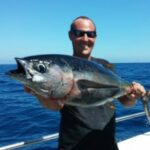Best Bait for Rainbow Trout – Rainbow Trout Fly Fishing Tips
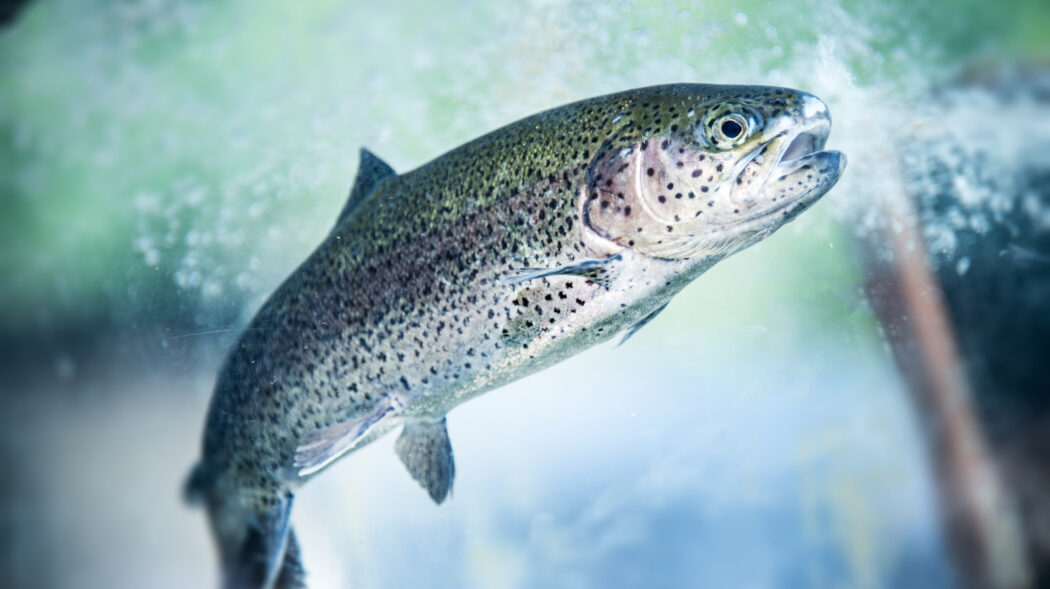
The fluid motion of fly line sings above the river as it’s pulled back and forth until gently, it lays down on the water. The dry fly at the end of the fly man’s rod follows the perfect motion of the line, until it also lands softly on the top water. The feather made fly sits in the surface tension for several seconds as it floats back down stream towards the fisherman. Then it happens. Slam! Coming from the depths, the 18 inch Rainbow hits so hard that it’s launched into the air as it takes the bait. The fly fisherman (check this article for best fly fishing reels) watches in wonder and respect, failing to even think of setting the hook until the trout lands back into the river. The best bait for Rainbow Trout often starts as salmon eggs, maggots, fishing boilies (see also is fish bait safe for dogs) and ends in Elk Hair Caddis.
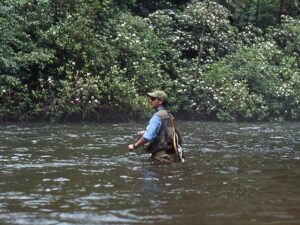
The Most Popular Baits for Catching Rainbow Trout
Quite a good number of fly fishermen didn’t start that way. We used spinning reels with Power Bait, and sat on the lake shore as quietly as we could. There are several types of bait available for catching trout, and they can all be extremely effective. Using these baits while lake fishing for Rainbow Trout is usually the best application, though a well placed lure cut through a stream can often trigger reaction strikes. The trouble fishing these baits in a river is that they must be floated on top, or they will get stuck in the rocks. Even then, they are nowhere near as effective as flys in a stream or river. None the less, they are good baits in their proper use. A quick look at the main ones.
Salmon Eggs
Three salmon eggs, one on each of a treble hook is the way I fished as a kid. I’d cast out in whichever Mammoth Lake we happened to be camping at that summer and wait. The stocked Rainbows loved this bait, and if a school swam by, you were likely to get a bite from one of them.
Garlic Power Bait
You remember the stuff? Power bait comes in many different flavors, but we always leaned towards the garlic cheese. You just scoop a small amount with your finger, enough to form a small dime sized ball. Form it over your hook, and let it fly. I’d switch to this bait if the salmon eggs didn’t seem to be working for whatever reason.
Bubble Floaters
We used to notice sometimes that the trout were hanging up top, so we bought these floaters. Very much like bobbers, but made of clear plastic. You could fill them part way with water to give them weight for casting. We’d use salmon eggs as trout bait and have some good luck using this method.
Spinning Lures
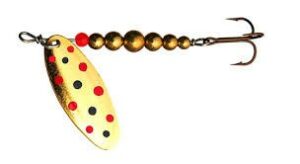 Once in a while we’d rent a small motor or row boat, and take it out onto the lake. I still remember my dad’s excitement the first time he threw a lure. It was a small gold lure, with a silver colored spoon that spun in the water when retrieved. He was reeling in moderately, not getting a bite, but saw a big Rainbow follow that shiny flashing lure right to the boa. We were both sold at that moment, and so began the transition to lure fishing.
Once in a while we’d rent a small motor or row boat, and take it out onto the lake. I still remember my dad’s excitement the first time he threw a lure. It was a small gold lure, with a silver colored spoon that spun in the water when retrieved. He was reeling in moderately, not getting a bite, but saw a big Rainbow follow that shiny flashing lure right to the boa. We were both sold at that moment, and so began the transition to lure fishing.
Why the Mayfly is the Best Bait for Rainbow Trout
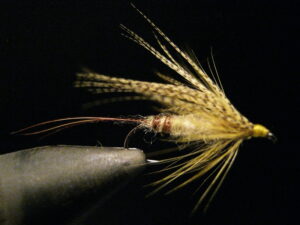 The Mayfly is the most common flying insect to hatch over trout rivers in North America. Whether it was the trout or the mayfly that came first, one thing is for certain, trout love mayfly. It’s an amazing life cycle that the mayfly fulfills (if not eaten by a hungry trout). Their eggs are laid by the female on the surface of the river just after mating. During this process the female mayfly is spent, and trout feed on them easily. The eggs float downstream until they nestle somewhere on the bottom. After a period of days to weeks, the eggs turn into nymphs. Nymphs are like water worms in streams. They latch on strongly to rocks or branches in the water. Nymphs are known to live in the water for long periods of time (up to 2 years) before they rise to the surface, and hatch. When they do hit the surface and hatch, they are again vulnerable to attack from fish. They are also vulnerable the entire time they are rising from the bottom to the top of the river.
The Mayfly is the most common flying insect to hatch over trout rivers in North America. Whether it was the trout or the mayfly that came first, one thing is for certain, trout love mayfly. It’s an amazing life cycle that the mayfly fulfills (if not eaten by a hungry trout). Their eggs are laid by the female on the surface of the river just after mating. During this process the female mayfly is spent, and trout feed on them easily. The eggs float downstream until they nestle somewhere on the bottom. After a period of days to weeks, the eggs turn into nymphs. Nymphs are like water worms in streams. They latch on strongly to rocks or branches in the water. Nymphs are known to live in the water for long periods of time (up to 2 years) before they rise to the surface, and hatch. When they do hit the surface and hatch, they are again vulnerable to attack from fish. They are also vulnerable the entire time they are rising from the bottom to the top of the river.
Nymph fishing, as it is called, is perhaps the most effective method of catching trout in a river. A nymph rising up through the water column is the easiest meal a trout can get. That 22 inch rainbow got that way by often just swimming in place, waiting for passing nymphs to simply gobble up. Often times fly fishermen can get trout to bite this way, when the dry surface fly on top isn’t working. I also learned a method of tying a leader of tippet (thin line) on to my dry fly, so I could fish dry fly on top and nymph below at the same time.
The Most Effective Dry Fly and Nymphs
 If you’ve ever spent any time inside a fly fishing store, then you know the range of dry flys and nymphs that are available. If the store has a good selection, there will be countless cubbies full of different patterns and sizes. I mentioned the Elk Hair Caddis before, and it is likely one of the best known dry fly patterns. But, it’s not always the pattern the fish are eating. Getting local information can be helpful, but studying the trout’s available food supply is better. Trout will eat small frogs and grasshoppers that land in the water. They’ll eat big bees and hornets too. And guess what size fish tend to eat these larger bugs? You guessed it, the larger models. It can very beneficial to have different patterns with you, and pay attention to what is landing on the water.
If you’ve ever spent any time inside a fly fishing store, then you know the range of dry flys and nymphs that are available. If the store has a good selection, there will be countless cubbies full of different patterns and sizes. I mentioned the Elk Hair Caddis before, and it is likely one of the best known dry fly patterns. But, it’s not always the pattern the fish are eating. Getting local information can be helpful, but studying the trout’s available food supply is better. Trout will eat small frogs and grasshoppers that land in the water. They’ll eat big bees and hornets too. And guess what size fish tend to eat these larger bugs? You guessed it, the larger models. It can very beneficial to have different patterns with you, and pay attention to what is landing on the water.
When it comes to matching nymphs, start by turning over some rocks that are in the water. It shouldn’t take long to find a few nymphs latched on. Once you see a few, you’ll know what to put on the end of your line. Pheasant Tailed Nymphs and Copper Johns are always two of my favorites, but again, not necessarily what the trout are eating.
See a Wild Rainbow Gleaming in the Sky
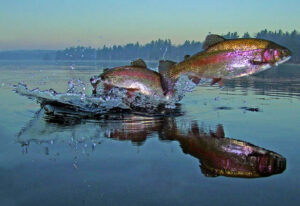 I love catching wild Rainbow Trout in a river, on a fly. Rainbow Trout are very well known for being aggressive fighting fish once hooked. They love to leap out of the water, and will often do so several times. When I started to get the hang of fly fishing, I was quite frankly amazed at how different a style of fishing it is. I felt immersed in a sport that I was a part of, and it was happening all around me. Standing waist deep in a quick current keeps your senses alive, and the sound of the water matched with the other sounds of nature just pulls a person in. More pointedly towards fishing, I found that flys are by no doubt the best bait for rainbow trout.
I love catching wild Rainbow Trout in a river, on a fly. Rainbow Trout are very well known for being aggressive fighting fish once hooked. They love to leap out of the water, and will often do so several times. When I started to get the hang of fly fishing, I was quite frankly amazed at how different a style of fishing it is. I felt immersed in a sport that I was a part of, and it was happening all around me. Standing waist deep in a quick current keeps your senses alive, and the sound of the water matched with the other sounds of nature just pulls a person in. More pointedly towards fishing, I found that flys are by no doubt the best bait for rainbow trout.
In Summary
Thank you for reading our guide on bait for rainbow trout fly fishing! Do you also fly fish for pike? If so, check out our handy guide.
We also have an article here about the best fly fishing vest that you might also be interested in.
As an Amazon Associate, Fishermen's Angle earns from qualifying purchases. We get commissions for purchases made through links in this post.
